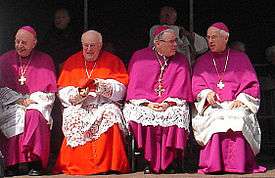Prelate
| Look up prelate in Wiktionary, the free dictionary. |
A prelate is a high-ranking member of the clergy who is an ordinary or who ranks in precedence with ordinaries. The word derives from the Latin prælatus, the past participle of præferre, which means "carry before", "be set above or over" or "prefer"; hence, a prelate is one set over others.
The archetypal prelate is a bishop, whose prelature is his particular church. All other prelates, including the regular prelates such as abbots and major superiors, are based upon this original model of prelacy.
Related terminology
A prelature is the office of a prelate or the entire juridical entity which the prelate governs. Prelacy is the body of prelates as a whole or a system of government, administration or ministry by prelates.
Sometimes the clergy of a state church with a formal hierarchy are called prelates without having ordinary jurisdiction.
Higher-ranking monsignors are given the title of honorary Prelate of H. H. In some countries such as Germany; they are addressed as Mr. Prelate while regular prelates are addressed with their other titles and respective courteous forms, such as Mr. Bishop, Your Lordship etc.
Territorial prelatures
A territorial prelature is, in Roman Catholic usage, a prelate whose geographic jurisdiction, called territorial prelature, does not belong to any diocese. A territorial prelate is sometimes called a prelate nullius, from the Latin nullius diœceseos, prelate "of no diocese", meaning the territory falls directly under the jurisdiction of the pope and is not a diocese under a residing bishop.[1] As of 2013, there were 44 territorial prelatures, all in the Latin Church.
The term also is used in a generic sense, in which case it may equally refer to an apostolic prefecture, an apostolic vicariate or a territorial abbacy.
Personal prelatures
In the Roman Catholic Church, the personal prelature was conceived during the sessions of the Second Vatican Council (1962 - 1965) in no. 10 of the decree Presbyterorum ordinis and was later enacted into law by Paul VI in his motu proprio Ecclesiae sanctae. The institution was later reaffirmed in the 1983 Code of Canon Law.[2] Such a prelature is an institution having clergy and (possibly) lay members which would carry out specific pastoral activities. The adjective personal refers to the fact that, in contrast with previous canonical use for ecclesiastical institutions, the jurisdiction of the prelate is not linked to a territory but over persons wherever they be. The establishment of personal prelatures is an exercise of the theologically inherent power of self-organization which the Church has to pursue its mission, though a personal prelature is not a particular church as dioceses and military ordinariates are.
Personal prelatures are fundamentally secular organizations operating in the world (members take no vows and live normal, everyday lives), whereas religious institutes are religious organizations operating out of the world (members take vows and lead lives in accordance with their specific organization).
The first (and as of 2012, only) personal prelature is Opus Dei, which was elevated to a personal prelature by Pope John Paul II in 1982 through the Apostolic constitution Ut sit. In the case of Opus Dei, the prelate is elected by members of the prelature and confirmed by the Pope, the laity and clergy of the prelature are still under the governance of the particular church where they live, and the laity associated with the prelature (both men and women) are organically united under the jurisdiction of the prelate.
See also
- Catholic Church hierarchy § Equivalents of diocesan bishops in law
- Ordinariate for the faithful of eastern rite
- Personal ordinariate
References
- ↑
 Herbermann, Charles, ed. (1913). "Prelate". Catholic Encyclopedia. New York: Robert Appleton Company.
Herbermann, Charles, ed. (1913). "Prelate". Catholic Encyclopedia. New York: Robert Appleton Company. - ↑ Personal Prelatures cann. 294–297
